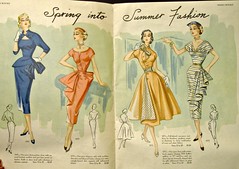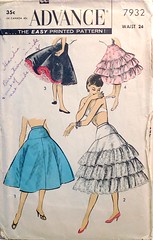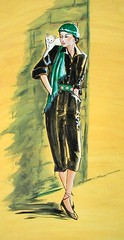A woman’s closet sixty years ago included several items we won’t find in our own. Girdles, for example, are literally a thing of the past. But that doesn’t mean they can’t be resurrected! There were different styles for different kinds of women, so this exploration, while by no means exhaustive, is intended to cover the basic elements of style for the beatnik babe to our effervescent housewife, and perhaps a few in between.
Here are a few items typically found in a woman’s closet during the decade that idealized the “living doll.” We are keeping ourselves to the bottom half for the moment, as there are many pieces to discuss. I hope someday to include them all in my own antique armoire (as yet to be purchased), but we’ll take it a step at a time.
This skirt, if laid out on the floor, is a complete circle. At the waist, all the material is gathered. Most skirts of this kind are not pleated or gathered unevenly--that would defeat the purpose. The purpose, if it is not obvious, is to allow the wearer to twirl magnificently across the floor, hopefully showing off no more than the dense fluff of ruffles that is her petticoat. As a child, I loved them because I could sit on the floor most romantically, my skirt spread out in all directions and able to cover me no matter how I sat. For more info, check out the post on circle skirts at This Girls Vintage blog.
This lovely item is a terror to one's closet (don't even think of storing it in a drawer!) and is the main reason, I am convinced, that women kept their clothes in large trunks at the foot of their beds. Petticoats can be very thin: a single layer of fabric gathered and ruffled to add volume to the skirt shape over top of it. Mostly, though, at least through the 1950s, they were ruffled and layered to the extreme to increase volume to circle skirts, and also to allow enterprising dancers to practice their can-cans with some degree of modesty. For more info, check out this section of Fashion-era.com. Also see Flounce, below.
Made extremely popular by Christian Dior (also attributed to designer Jacques Fath, whose sketch is shown at left), this skirt--like the circle skirt--is well-known for its ability to promote a certain silhouette. It accentuates one's natural curves by hugging all of them, sometimes (preposterously) past the knee. Think about trying to walk with your knees bound together. Still, I prefer this skirt over the circle skirt because of how it lends itself to a womanly maturity where the other does not. If you look for vintage skirts of this kind in thrift stores or vintage shops, take care to only buy skirts either with a lining or clearly made of a strong, firm fabric well-sewn. The best, of course, are tailor-made for one's figure, but as most of us cannot afford such luxury, we must make do with skirts that will at least avoid the risk of embarrassing us in public by tearing disastrously and always at the wrong time. A more full description can be found at the HeyViv blog.

One of my favorite words to say aloud. And strictly speaking, it isn't a garment of itself. Flounces are simply stiff, ostentatious ruffles - down the side of a gown, for instance. On collars, flounces are distinguished from ruffles in that they stand up while ruffles lay down. On skirts, picture Scarlett O'Hara in her white ball gown. Those are flounces. Flounces in the 1950s are better observed in the image at the right. They can edge sleeves, make skirts more exciting (as they are usually visible a few inches below the hemline), or insist on being the whole skirt, as with Scarlett. Buoyant and fun, flounces are decidedly my favorite garment embellishments. Learn how to make them yourself from the Off the Cuff blog!
Cropped pants / pedal-pushers / Capri pants
Christian Dior ushered in the era of cropped, fitted pants and cropped blouses, along with about a hundred other fashion concepts. These pants were useful to women who regularly rode bicycles (wider-legged pants and skirts tended to get caught in chains and gears) and were iconic for young people in the '50s and '60s.
It should be noted that Capri pants were designed and introduced by Sonja de Lennart in the 1940s, but are also attributed to Emilio Pucci who sold them in his boutique on the Isle of Capri in the late 1940s. They were made famous when Hollywood costume designers used them in such movies as Roman Holiday and Sabrina, and were quite frequently paired with ballet flats (a style happily resurrected in the last decade). A history of Capri pants can be found at SpeakFashion.us.
Dungarees (a.k.a. jeans)
Personally, I prefer the term "dungarees," so I might start a campaign to resurrect it. Back in the day, you couldn't find them made with comfortably-stretchy spandex - they were just denim. Most of us have worn just-denim jeans… and most of us prefer the way that bit of spandex allows them to move with you. They were originally designed for cowboys (and are still worn by them), but became popular with teenagers in the 1950s. You'll likely recognize the original brands - Levi's, Lee, and Wrangler.
James Dean popularized them among teens with his movie Rebel Without A Cause. For a while, dungarees were banned from theaters, restaurants, and schools because of their rebellious and untraditional connotations. The image seems to have stayed with us in some ways - jeans are decidedly not "formal attire" or appropriate for many formal functions. A little more of their history can be found at eHow.com.
In Part 2, we'll explore tops of all kinds. Also check back for posts on outerwear, unmentionables, shoes, and accessories. There's a world of vintage fashion to investigate and try on for ourselves, and we've only touched the surface!










